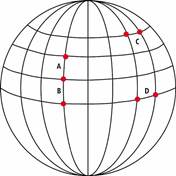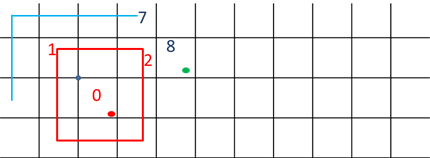自定义经纬度索引(非RTree、Morton Code[z order curve]、Geohash的方式)
自定义经纬度索引(非RTree、Morton Code[z order curve]、Geohash的方式)
Custom Indexing for Latitude-Longitude Data
网络上有一些经纬度索引的文章,讨论的方法是用Geohash、RTree、Z-Order Curve(morton Code)等算法来将经纬度由二维变为一维的索引。
这篇文章介绍一种使用二维数据索引的方式来创建经纬度索引。前半部分讨论一种自定义的、使用二维数组的方式将经纬度变为一维数据,来加快索引。
文章最后实现了查找附近几公里的方法。常见的一些应用是根据某个经纬度点,计算出一定范围内的其他坐标点。这些坐标点是景区、商场等。中文网络里,有讲GeoHash、RTree的一些文章,但都不够全面,只是介绍了如何实现Geohash或Rtree,但没有介绍到最后一个终极目标,即给定一个经纬度 latitude\longitude和距离radius,如何实现查找一定范围内的所有的点。
本文来源于MSDN杂志的一篇文章,请参考:
https://msdn.microsoft.com/en-us/magazine/jj133823.aspx
它有提供源代码下载,但我去下载的时候,提供的是错误的代码。
通常,我们在数据库里会有一张表保存如下的关系:
Id latitude - longitude
0001 47.610 - 122.330
0002 36.175 - 115.136
0003 47.613 - 122.332
Id代表某个主键,可以是一个小吃店、商场等。Latitude – longitude 表示该ID所对应的坐标。
一些应用场景包括:
1) 要找出在一定经纬范围内的所有ID:
SELECT Id
FROM IdInfoTable
WHERE latitude >= 47.0 AND latitude < 48.0
AND longitude >= -123.0 AND longitude < -122.0
2)还有一些应用是用户会根据自己的坐标点来查找,比如我在 47.003 – 122.311附近,我要找附近5公里范围的所有小吃店。一种最笨的方法是逐一遍历表里每一条数据,如果2个坐标点的距离小于5就把这个ID留下作为搜索结果输出。根据2个经纬度坐标点来计算2个经纬度之间距离的方法,可以参考:
http://www.cnblogs.com/softfair/p/distance_of_two_latitude_and_longitude_points.html
另外一种简单的想法是:
我们可以考虑把一对经纬映射到一个区域ID(sectorID)。
latitude – longitude Sector ID
47.610 - 122.330 49377
36.175 - 115.136 45424
47.613 - 122.332 49377
Id Sector ID
0001 493770002 454240003 49377如果某些经纬度都映射到统一个SectorID,那这个ID,我都可以返回。设想有如下一个应用。我根据地图上红色坐标点,得到一个SectorID,假设为49377,我本地保存的信息表IdInfoTable里,也把经纬度信息映射为SectorID,那我做查询:
SELECT Id
FROMIdInfoTable
WHERE sector = 49377就能立刻找到我需要的哪些ID是与图上红色点经纬度相同的一个区域的。

经纬度一种简单的划分,就是二维数组:
首先第一步,就是考虑如何将全球的经纬度划分开,比如我这里是每0.5度划分一小格。如下图,fraction = 0.5 表示间隔数。即每一度间隔0.5。
纬度从-90 到 90度。可以划分为:
[-90.0, -89.5)
[-89.5, -80.0)
[-80.0, -79.5)
….
[89.5, 90.0]
最后一个是闭合区间,让它包含90度。如下表格的第一列所示,这样纬度间隔总共有360度。
90-(-90)/0.5=360
经度从-180 到 180度,按照0.5间隔划分,可以表示为:
[-180.0, -179.5)
[-179.5, -170.0)
…..
[179.5, 180.0]
最后一个是闭合区间,让它包含180度。如下表格第一行所示。这样纬度间隔总共有720度。
180-(-180)/0.5=720
表格的行代表纬度,一行代表0.5度的跨度。
表格的列代表经度,一列代表0.5度的跨度。
表格总共有360 * 720 = 259,200个,序号从 0 到259,199。
|
fraction = 0.5 |
[-180.0, -179.5) 0 |
[-179.5, -170.0) 1 |
[-170.0, -169.5) 2 |
[179.5, 180.0] 719 |
|||
|
[-90.0, -89.5) -> 0 |
0 |
1 |
2 |
... |
719 |
||
|
[-89.5, -89.0) -> 1 |
720 |
721 |
722 |
... |
1439 |
||
|
[-80.0, -79.5) -> 2 |
1440 |
1441 |
1442 |
... |
|||
|
... |
|||||||
|
[89.5, 90.0] -> 359 |
258,480 |
... |
259,199 |
||||
表1
上面使用了fraction=0.5来划分全球的经纬度。你也可以使用更小的间隔来划分全球的经纬度。这个会得到更多的sectorID。更甚者 纬度行使用0.5来划分,经度列用0.2来划分。(最好不要使用0.1这类计算机无法精确表示的浮点数。)这里演示只用0.5。
如果有一个纬度latitude的row索引 ri,有一个经度longitude的列col索引ci,则sectorID是:
sid = (ri * 360 * 1/fraction) + ci例如:上表格里,Sector 1441的行索引 ri 是2,列索引 ci 是1。
(2 * 360 * 1/0.5) + 1 = (2 * 720) + 1 = 1441.
360 * 1/fraction 这个因子决定了每一行有多少个列(经度360度分为多少份)。这个因子乘以ri就是这一行第一个sectorID。加上ci 就是往该行偏移ci个列,就是最终的SectorID。
下一个难题是如何找到经纬度的索引ri 和ci。笨的办法是遍历所有经纬度找到合适的索引,例如遍历一遍纬度,如上表格从0 到359遍历找到给定纬度的ri,再从经度的0到719遍历,找到给定经度的ci。遍历的多少取决于切分的粒度,切的越细,遍历区间越大。另外一种就是二分查找。
代码如下,纬度索引返回的是行ri值,经度索引返回的是列ci值。它们2个函数是相似的,区别只是在LonIndex函数中把常量180需要替换为360;-90 替换为-180;90替换为180。
static int LatIndex(double latitude, double fraction)
{
latitude = Math.Round(latitude, );
int lastIndex = (int)( * (1.0 / fraction) - );
double firstLat = -90.0;
if (latitude == -90.0) return ;
if (latitude == 90.0) return lastIndex;
int lo = ;
int hi = lastIndex;
int mid = (lo + hi) / ;
int ct = ; // To prevent infinite loop
while (ct < )
{
++ct;
double left = firstLat + (fraction * mid); // Left part interval
left = Math.Round(left, );
double right = left + fraction; // Right part interval
right = Math.Round(right, );
if (latitude >= left && latitude < right)
return mid;
else if (latitude < left)
{
hi = mid - ; mid = (lo + hi) / ;
}
else
{
lo = mid + ; mid = (lo + hi) / ;
}
}
throw new Exception("LatIndex no return for input = " + latitude);
}
上面方法里经纬度用的double。Double、float在计算机里有精度问题,某些数据是表示不正确的,一般也不能用 = 来进行相等比较,例如 double a=-1, b=-1, 这时候计算机判断 a==b就是false。还有一些除不尽的数也是不能直接=比较的。但可以截取一个有效位数,然后进行比较。为避免equality-of-two-type-double 错误,2个double或float类型数据是不能比较大小的。所以这里取一个8位有效数字,然后进行比较。上面的函数的主循环里检查[a,b) 这个区间。所以需要显示的判断 90这个最后一个值。
有了上面的方法介绍,下面就可以把经纬度映射到sectorID了。
static int LatLonToSector(double latitude, double longitude,
double fraction)
{
int latIndex = LatIndex(latitude, fraction); // row
int lonIndex = LonIndex(longitude, fraction); // col
return (latIndex * * (int)(1.0 / fraction)) + lonIndex;
}
Sector 面积的问题。
因为根据上面fraction分割经纬度的方法是将地球平面平均的分割为若干个小块。但这些小块的面积是不一样大小的。如下图:纬线之间是平行的,每一纬度之间的距离,例如A的距离、B的距离大约是111KM。经线之间是在赤道上距离远,靠近极点附近的距离近,例如C的距离是比D的距离要小的。所以一个小块的面积在不同纬度上是不一样的。

图1
2个坐标点之间的距离计算方法如下:参考:经纬度距离计算(给定2个经纬度,计算距离) http://www.cnblogs.com/softfair/p/distance_of_two_latitude_and_longitude_points.html
public static double Distance(double lat1, double lon1,
double lat2, double lon2)
{
double r = 6371.0; // approx. radius of earth in km
double lat1Radians = (lat1 * Math.PI) / 180.0;
double lon1Radians = (lon1 * Math.PI) / 180.0;
double lat2Radians = (lat2 * Math.PI) / 180.0;
double lon2Radians = (lon2 * Math.PI) / 180.0;
double d = r * Math.Acos((Math.Cos(lat1Radians) *
Math.Cos(lat2Radians) *
Math.Cos(lon2Radians - lon1Radians)) +
Math.Sin(lat1Radians) * Math.Sin(lat2Radians)));
return d;
}
所以,如果知道一个Sector的起始经纬度(latitude, longitude)是能够计算这个sector的长、宽和面积的。
以下是把sectorID转化为起始纬度的函数:
static double SectorToLat(int sector,
double fraction)
{
int divisor = * (int)(1.0 / fraction);
int row = sector / divisor;
return -90.0 + (fraction * row);
}
这个函数是LatLonToSector的一个逆向操作。例如给定sectorID=1441,fraction=0.5如上表格,
divisor = 360 * 1.0 / 0.5 = 720 表示有多少个列,是经度的间隔。1441 / 720 = 2 就是行row索引ri。-90.0 + 0.5 * 2 = -90.0 + 1.0 = -89.0 就是[-89.0, -79.5)这个区间的起始纬度。
获得起始经度的方法是类似的:
static double SectorToLon(int sector, double fraction)
{
int divisor = * (int)(1.0 / fraction);
int col = sector % divisor;
return -180.0 + (fraction * col);
}
sector % divisor 取模表示所在的列ci。
根据以上2个方法,可以计算面积:
static double Area(int sector, double fraction)
{
double lat1 = SectorToLat(sector, fraction);
double lon1 = SectorToLon(sector, fraction);
double lat2 = lat1 + fraction;
double lon2 = lon1 + fraction;
double width = Distance(lat1, lon1, lat1, lon2);
double height = Distance(lat1, lon1, lat2, lon1);
return width * height;
}
临近区块(Adjacent Sectors)
有时候,找到当前Sector是不够的,还需要找到临近的Sector。例如在721块的时候,临近Sector是0, 1, 2, 720, 722, 1440, 1441 和 1442共八个块。左右Sector就是SectorId减或加1得到。上下的Sector就是SectorId减加一行所具有的列数总数即360 * (1 / fraction)。另外需要注意的几个特殊Sector,他们可能是四个角上的、或者是第一行的sector、或者是最后一行的sector,它们临近的sector是不全的。需要额外判断。以下是判断临近块的方法:
static bool IsLeftEdge(int sector, double fraction)
{
int numColumns = (int)(1.0 / fraction) * ;
if (sector % numColumns == ) return true;
else return false;
}
static bool IsRightEdge(int sector, double fraction)
{
if (IsLeftEdge(sector + , fraction) == true) return true;
else return false;
}
static bool IsTopRow(int sector, double fraction)
{
int numColumns = (int)(1.0 / fraction) * ;
if (sector >= && sector <= numColumns - ) return true;
else return false;
}
static bool IsBottomRow(int sector, double fraction)
{
int numColumns = (int)(1.0 / fraction) * ;
int numRows = (int)(1.0 / fraction) * ;
int firstValueInLastRow = numColumns * (numRows - );
int lastValueInLastRow = numColumns * numRows - ;
if (sector >= firstValueInLastRow && sector <= lastValueInLastRow)
return true;
else
return false;
}
下面的函数是返回临近点的函数。返回数组里,
result[0]是左上角的SectorId,
result[1]是正上方的SectorId,
result[2]是右上角的SectorId,
result[3]是正左方的SectorId,
result[4]是正右方的SectorId,
result[5]是左下角的SectorId,
result[6]是正下方的SectorId,
result[7]是右下角的SectorId,
static int[] AdjacentSectors(int sector, double fraction)
{
int[] result = new int[]; // Clockwise from upper-left
int numCols = (int)(1.0 / fraction) * ;
int numRows = (int)(1.0 / fraction) * ;
int firstValueInLastRow = numCols * (numRows - );
int lastValueInLastRow = numCols * numRows - ;
// General case
if (IsLeftEdge(sector, fraction) == false &&
IsRightEdge(sector, fraction) == false &&
IsTopRow(sector, fraction) == false &&
IsBottomRow(sector, fraction) == false)
{
result[] = sector - numCols - ;
result[] = sector - numCols;
result[] = sector - numCols + ;
result[] = sector - ;
result[] = sector + ;
result[] = sector + numCols - ;
result[] = sector + numCols;
result[] = sector + numCols + ;
return result;
}
// Deal with special cases here. See code download.
throw new Exception("Unexpected logic path in AdjacentSectors");
}
有时候,仅仅查找临近的8个节点是不够的。例如:在高纬度地区。如下图所示,中心区域是红色的,它四周的8块Sector是绿色的。如果Fraction很小,导致红色区域的宽和高都比较小,例如有可能红色Secotor的宽高是2*10,则当需要查找附近10公里的时候,宽度需要向外延生,比如说左边,需要向外延生5个临近快。因为如果当前的点是红色Sector的起始点,即红色块左下角点时,左边就需要向外延生5*2公里。这样才能完全覆盖住半径10公里的范围。也就是下图中黑色线条标出的左边方向的5个Sector,每个Secotr的宽是2。黑色线条就一个10公里半径(以红色Sector左下角作为圆心)。
这样扩展后,会找到更多的点,包括哪些可能不是10公里范围内的点。那就需要再用距离公式对这些范围内的点再做精确的距离计算,来剔除掉一些额外点,保留下尽在范围的点。

/// <summary>
/// 根据经纬度、半径查找临近节点,会递归查找,找到该半径区域大小的所有Sector。
/// </summary>
/// <param name="latitude">纬度</param>
/// <param name="longitude">经度</param>
/// <param name="radius">半径</param>
/// <param name="fraction"></param>
/// <returns>SectorID</returns>
public HashSet<int> FindClosedAdjacentSectors(double latitude, double longitude, double radius)
{
if (radius > 200.0)
{
throw new Exception("半径太大"); //超过200公里,国内查找实际意义不太大。
}
//这里使用List来保存所有的sector,再最后输出的时候再去重复。
//因为下面的查找用的是深度优先递归查找,实际测试中发现,如果用HashSet会遗漏掉几个点。
var allFoundSectorIdSet = new List<int>();
var centralSectorId = MapLonLatCalc.LatLonToSector(latitude, longitude, Fraction);
allFoundSectorIdSet.Add(centralSectorId);
//计算当前sector的宽和高
var w = 0.0; var h = 0.0;
MapLonLatCalc.SectorArea(centralSectorId, Fraction, out w, out h);
GetAdjacentSectorsRecursively(centralSectorId, allFoundSectorIdSet,radius+w,radius+h, );//给宽度+w,高度+h,冗余,不同经纬度上多找一些。以免遗漏
return new HashSet<int>(allFoundSectorIdSet);
}
在这里,我做递归查找时,将宽和高都额外给了一个距离,这个距离是中心块的宽和高。上面介绍的SectorToLat和SectorToLon得到的lat和lon都是Sector左上角的坐标位置(如下图蓝色点位置),一个Sector是一个矩形。如果我们输入的源点是蓝色点,那递归查找时,无需额外的增加宽和高。但如果我们输入的源点是红色的点的位置,在做半径10公里这类查找时,我们就需要额外的把红色点所在的Sector的宽和高给补足进去。代码里计算的距离的参考点都是以蓝色的点为基准的。

以上代码使用List<int> 来保存所有找到的SectorId,会存在重复的Sector,原来使用的HashSet保存,直接在查找时就去重复,但测试后发现一些问题。例如上图,中心Sector是0,首先找到周边8个Sector并保存,然后开始深度搜索递归,从Sector1首先开始,而Sector1它会优先查找到天蓝色线条所在的Sector,当找到Sector7的时候,Sector7又深度优先,会直接把Sector2找到保存下来,当Sector1周边所有都找遍完了,轮到Sector2来递归查找时,发现Sector2已经找过了,就跳过了。导致Sector8没有被包含进来。这就出现了错误。所以现在使用List保存所有Sector,最后再去重复。
递归查找:
/// <summary>
/// 递归查找临近区域的SectorId
/// </summary>
/// <param name="sectorId">当前SectorID</param>
/// <param name="allSectors">已经存在的SectorId,每找到一个就存入</param>
/// <param name="accumulatedWidth">累计的宽度,这里其实是剩余的宽度</param>
/// <param name="accumulatedHeight">累计的高度,这里其实剩余的宽度</param>
/// <param name="recursiveTime">递归次数,避免死死循环</param>
/// <param name="fraction"></param>
private void GetAdjacentSectorsRecursively(int centorSectorId, List<int> allSectors,double remainWidth,double remainHeight, int recursiveTime)
{
if (recursiveTime <= )
{
return;
}
var result = MapLonLatCalc.AdjacentSectors(centorSectorId, Fraction);
for (int i = ; i < result.Length; i++)
{
var sId = result[i];
if (sId > -)
{
allSectors.Add(sId);
//计算当前sector的宽和高
var w = 0.0; var h = 0.0;
MapLonLatCalc.SectorArea(sId, Fraction, out w, out h);
var leftWidth = remainWidth - w;//还剩余多少没有找到?如果>0,就需要递归查找,低纬度与高纬度值不一样。
var leftHeight = remainHeight - h; //看看剩余的高,高是同一经线上的2个维度距离。所以高是平均相等的。
//只要有剩余的宽和高,就递归去找。可多找,不可少找
// 这里有个问题,在极点附近lat接近90 的时候,Sector就是几个,无论怎么递归查找,leftWidth 和leftHeight有可能永远>0.
//所以在数据源上要做限制,不允许有极点附近的坐标。还好,目前国内或国外的查找点在极点附近基本没有什么。
if (leftWidth > || leftHeight > )
{
GetAdjacentSectorsRecursively(sId, allSectors,leftWidth,leftHeight, recursiveTime - );
}
}
}
}
在极点附近的时候,这里有个问题,在极点附近lat接近90 的时候,Sector就是几个,无论怎么递归查找,leftWidth 和leftHeight有可能永远>0.
所以在数据源上要做限制,不允许有极点附近的坐标。还好,目前国内或国外的查找点在极点附近基本没有什么。
测试程序:
随机生成一批坐标点,纬度范围控制在 -85 到85之间。目前地球上85度纬度以上的地区基本无有效信息可查。微软Bing地图也在这个范围内。
static void InitLatLon()
{
Random r = new Random(); //initialDataFile="..\\..\\UserIDLatLon.txt";
FileStream ofs = new FileStream(initialDataFile, FileMode.Create);
StreamWriter sw = new StreamWriter(ofs);
for (int i = ; i < ; ++i)
{
double lat = (85.0 - (-85.0)) * r.NextDouble() + (-85.0);
double lon = (180.0 - (-180.0)) * r.NextDouble() + (-180.0);
sw.WriteLine(i.ToString().PadLeft(, '') + "," +
lat.ToString("F8") + "," + lon.ToString("F8"));
}
sw.Close(); ofs.Close();
}
MyCusterInfo 是模拟现实中的一个实际业务中可能需要的一些地理信息。它除了ID、经纬度坐标外,可能还包含其他信息,这里用ExtraInfo表示。
public class MyCusterInfo
{
public int Id
{
get;
set;
}
public double LAT
{
get;
set;
}
public double LON
{
get;
set;
}
/// <summary>
/// 额外信息
/// </summary>
public object ExtraInfo
{
get;
set;
}
}
从文件中把经纬度信息读取出来放在内存中:
Dictionary<int, MyCusterInfo> myLatLonCusterInfo = new Dictionary<int, MyCusterInfo>();
//initialDataFile = "..\\..\\UserIDLatLon.txt";
FileStream ifs = new FileStream(initialDataFile, FileMode.Open);
StreamReader sr = new StreamReader(ifs);
string line = "";
string[] tokens = null;
while ((line = sr.ReadLine()) != null)
{
tokens = line.Split(','); int id = int.Parse(tokens[]);
double lat = double.Parse(tokens[]);
double lon = double.Parse(tokens[]); bool vld = false;
double vlat = -1.0, vlon = -1.0;
vld = findObjects.ConvertToValidLatLon(lat, lon, out vlat, out vlon); if (vld)
{
var obj=new MyCusterInfo { Id = id, LAT = vlat, LON = vlon };
myLatLonCusterInfo[id]=obj;
}
}
完整代码,请从这里获取: http://download.csdn.net/detail/soft_fair/8680673
经过测试程序,发现使用笨办法 和使用这个自定义经纬度索引的方法,返回的结果数是一致的。自定义索引的方法更快、更高效。目前已经应用于互联网生产环境。
自定义经纬度索引(非RTree、Morton Code[z order curve]、Geohash的方式)的更多相关文章
- 温故知新-Mysql索引结构&页&聚集索引&非聚集索
文章目录 摘要 索引 索引概述 索引优势劣势 索引结构 BTREE 结构 B+TREE 结构 页 索引分类 索引语法 索引设计原则 聚触索引 & 非聚触索引 你的鼓励也是我创作的动力 Post ...
- Morton Code
莫顿码 ,实现了一维与二维(或多维)的转换.它通过交叉存储两个数的位产生一个数,即莫顿码. 可以应用于为一个整数对产生一个唯一索引. 例如,对于坐标系中的坐标点使用莫顿编码生成的莫顿码,可以唯一索引对 ...
- Mysql 索引实现原理. 聚集索引, 非聚集索引
Mysql索引实现: B-tree,B是balance,一般用于数据库的索引.使用B-tree结构可以显著减少定位记录时所经历的中间过程,从而加快存取速度.而B+tree是B-tree的一个变种,My ...
- Mysql 自定义HASH索引带来的巨大性能提升----[真相篇]
推倒重来 俗话说no zuo no die why you try,这时候我又忍不住zuo了,吭哧吭哧的把解决过程发上博客,向全世界宣布,哥又搞定个难题. 剧情的发展往往是看起来主角完全掌握了局势的情 ...
- Mysql 自定义HASH索引带来的巨大性能提升----[挖坑篇]
有这样一个业务场景,需要在2个表里比较存在于A表,不存在于B表的数据.表结构如下: T_SETTINGS_BACKUP | CREATE TABLE `T_SETTINGS_BACKUP` ( `FI ...
- MYSQL的全表扫描,主键索引(聚集索引、第一索引),非主键索引(非聚集索引、第二索引),覆盖索引四种不同查询的分析
文章出处:http://inter12.iteye.com/blog/1430144 MYSQL的全表扫描,主键索引(聚集索引.第一索引),非主键索引(非聚集索引.第二索引),覆盖索引四种不同查询的分 ...
- cassandra——可以预料的查询,如果你的查询条件有一个是根据索引查询,那其它非索引非主键字段,可以通过加一个ALLOW FILTERING来过滤实现
cassandra的索引查询和排序 转自:http://zhaoyanblog.com/archives/499.html cassandra的索引查询和排序 cassandra的查询虽然很弱,但 ...
- Mysql 自定义HASH索引带来的巨大性能提升
有这样一个业务场景,需要在2个表里比较存在于A表,不存在于B表的数据.表结构如下: T_SETTINGS_BACKUP | CREATE TABLE `T_SETTINGS_BACKUP` ( `FI ...
- 自定义 异步 IO 非阻塞框架
框架一 自定义Web异步非阻塞框架 suosuo.py #!/usr/bin/env python # -*- coding: utf-8 -*-# # __name__ = Web_Framewor ...
随机推荐
- 【OCP 12c】最新CUUG OCP-071考试题库(63题)
63.(22-4) choose the best answer: View the Exhibit and examine the data in the PRODUCTS table. Which ...
- 【扫盲】HTML5、Web APP、3G网站、Wap网站傻傻分不清楚
移动互联网指手机网站和app,其中app分为native app(原生app),web app(html5开发),Hybrid app(前两种app结合):手机网站分为wap网站和3g网 ...
- SQL中DateTime转换成Varchar样式
SQL中DateTime转换成Varchar样式语句及查询结果:Select CONVERT(varchar(100), GETDATE(), 0): 05 16 2006 10:57AMSelect ...
- instanceof,isinstance,isAssignableFrom,asSubclass的区别
1,isAssignableFrom():是字节码对象的方法 是用来判断一个类的字节码对象和另一个类的字节码对象是否相同或是子类或接口. assignable英 [ə,sainəbl]美 [ə,sai ...
- 孩子们各显神通对付 iOS 12「屏幕使用时间」的限制
简评:2018 年秋季,苹果公司推出了 iOS 12,其中备受好评的一项改变是:增加了屏幕使用时间限制,以减轻沉迷手机的状况.三个月过去后,这项功能似乎并没有对孩子造成太多困扰,道高一尺魔高一丈,孩子 ...
- C#-WebForm-设置div边框为内边框:box-sizing:border-box;
设置div边框为内边框:box-sizing:border-box;
- 11种绕过CDN查找真实IP方法
0x01 验证是否存在CDN 方法1: 很简单,使用各种多地 ping 的服务,查看对应 IP 地址是否唯一,如果不唯一多半是使用了CDN, 多地 Ping 网站有: http://ping.chin ...
- Log中关于zVideoApp与zChatApp之间的消息传递可以搜索以下字符串
[CSSBConfIPCAgent::OnMessageReceived] (这是zVideoApp端的) 和 [CSSBPTIPCListener::OnMessageReceived] ...
- 【CF1157F】Maximum Balanced Circle 求一个相邻元素之间绝对值为小于1的最大环
题目: https://codeforces.com/contest/1157/problem/F 给出一个序列 , 我们要从序列里面挑出一些数构造成一个相邻元素之间绝对值为小于1的最大环 , 挑选的 ...
- laravel 表单接收
POST方式接收 视图层 <form action="/submit" method="post"> {{csrf_field()}} //必 ...
